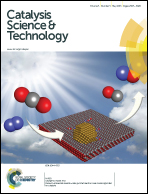A theoretical study on the catalytic role of water in methanol steam reforming on PdZn(111)†
Abstract
Methanol steam reforming (MSR) is a promising method for large-scale production of hydrogen. While significant efforts have been devoted to the reaction mechanisms, the function of water except serving as a reactant is little known. Here we present a density functional study of the catalytic role of water in the whole MSR process on the PdZn(111) surface. It is shown that water not only influences the adsorption of reaction species but also the kinetics of the elementary steps of MSR. The calculated adsorption energies of reaction species including CH3OH*, CH3O*, H2COOH*, HCOOH* and HCOO* increase by some 0.10–0.30 eV in the presence of co-adsorbed water. Importantly, water is found to substantially favor six dehydrogenation steps of MSR through lowering the activation barriers by 0.25–0.46 eV without being consumed, providing compelling evidence for the catalytic role of water in MSR. Depending on the manner in which water participates in the reactions, the catalytic mechanisms of water are classified into two categories, the solvation effect and the H-transfer effect. For the dehydrogenation steps involving O–H bond cleavage, both of the two mechanisms are applicable and show a slight difference in reducing the reaction barriers. However, for the dehydrogenation steps involving C–H bond cleavage, the catalytic function of water can only be realized through the solvation effect. These results uncover the catalytic role of water in MSR and are helpful in understanding the water effect in other chemical transformations.


 Please wait while we load your content...
Please wait while we load your content...